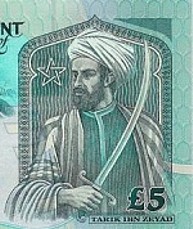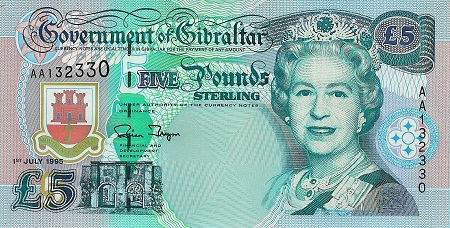GIBRALTAR
Tarik ibn Ziyad

Tarik ibn Ziyad was born into the North African Berber tribe Nafzawah, and after the death of his father, joined the Muslim army in Northern Africa. As a young soldier, Ziyad had shown great skill in the army and had a strong Muslim faith. This was noticed by Musa ibn Nusair, who made him his deputy and appointed him the Governor of Tangier and Morocco. Nusair was the first governor of a land called Ifriquia (now Libya, Tunisia and Algeria) who was not answerable to the governor of Egypt.
Though the Visigoths were in control of most of the Iberian Peninsula at this time, they were involved in a civil war. The Vizigoth King Witiza had died and the nobles selected Roderic to be king, neglecting Witiza’s heirs. These sons of Witiza, Sisiberto and Oppas, were battling for their right to the throne.
At the same time, Julian, the Roman governor of Ceuta (a city in North Africa just across from Gibraltar) had become enraged at Roderic for the alleged rape of his daughter who had been sent to study in Spain. Julian asked the Heirs of Witiza to seek the assistance of the Muslim Arabs to defeat Roderic. They agreed and Julian went to Musa ibn Nusair to ask for military assistance.
Musa ibn Nusair and Tarik ibn Ziyad were intrigued at the possibility of invading Iberia and spreading the Mulsim faith. They asked their superior, the caliph in Damascus, for permission to invade Spain as a pretense of aiding the Heirs of Witiza, defeat Roderic and spread the Muslim faith. After scouting parties were sent, the order was given to proceed. Musa ibn Nusair sent Tarik ibn Ziyad to Spain with Julian aiding with ships.
Once the straight was crossed it is thought that Ziyad burned the ships in order to create a great resolve among his warriors, as there was no possible retreat. Zayid gave a great, rousing speech to his men , emboldening them to fight bravely, promising great rewards and pleasures for victory, and telling his men that he would lead the fight, but if he should fall, that they should resolve to fight all the harder to defeat Roderic.
On 19 July 711, with an army of over 7,000 men, Tarik ibn Ziyad pressed on through Gibraltar and began fighting against the forces loyal to Roderic in the Battle of Guadalete. Julian and his cadre had been spreading the word that the Muslim army (Moors) was there only to spread their message of faith, peace and liberty. This caused a cavalry unit of Roderics to fight along with the Ziyad, leaving Roderics army confused and demoralized. This ushered in the success of Ziyad’s army and the defeat of Roderic. Roderic was thought to have died in battle, but other sources say that he fled, abandoning his army.
In little over a year, all the major cities of the Iberian Peninsula had been conquered. The following year saw the whole peninsula under Moorish rule. In 712 Musa ibn Nusair went to Spain, but was called to Damscus by Caliph al-Waleed. Not wanting to give his subordinate full reign in Spain, Musa jailed Tarik. Tarik eventually sent word to the Caliph, who then summoned both Tarik ibn-Ziyad and Musa ibn-Nusair to Damasus. Tarik arrived ahead of Musa, just as the Caliph was getting ill. The Caliph’s brother sent a messenger to Musa to delay his entrance into Damascus until the Caliph was better. Musa ignored this and entered the city, appearing before an ill Caliph. The Caliph then heard from both Musa and Tarik and rules in Tarik’s favor. Musa was stripped of his title, and his spoils of war.
This invasion was not to the detriment of the Iberian peoples, however. The Moors brought with them knowledge, culture and traditions which helped make Spain a world power. Under Muslim rule, the Christian and Jewish peoples were free to worship as they pleased, and were known as “The People of the Book”. Land ownership was largely left alone, and the agriculture in the region flourished. The Moors established public baths, gardens, mosques, palaces and centers of science and learning which attracted many of the wealthy and learned throughout Europe. Some scholars contend that this ushered in the renaissance age to Europe. The Iberian Peninsula remained under Moorish control for over 700 years.
Though the Rock of Gibraltar became known as Jabal Tarik (meaning the mountain of Tarik, after Tarik ibn Ziyad) little was done with the area for the first four centuries of Moorish control. The famous fortification on the rock was built by Abd al-Mu’min in 1160. This fortress and a small city were the first permanent settlement on Gibraltar. Jabal Tarik was morphed over time into the name we know of today as Gibraltar.
Gibraltar is a United Kingdom Dependant Colony. It is approximately 6 miles in circumference and rises to 1396 feet. It is mainly comprised of limestone. The rock itself is the ancient Mount Calpe, which with Ceuta constituted the famous Pillars of Hercules.

